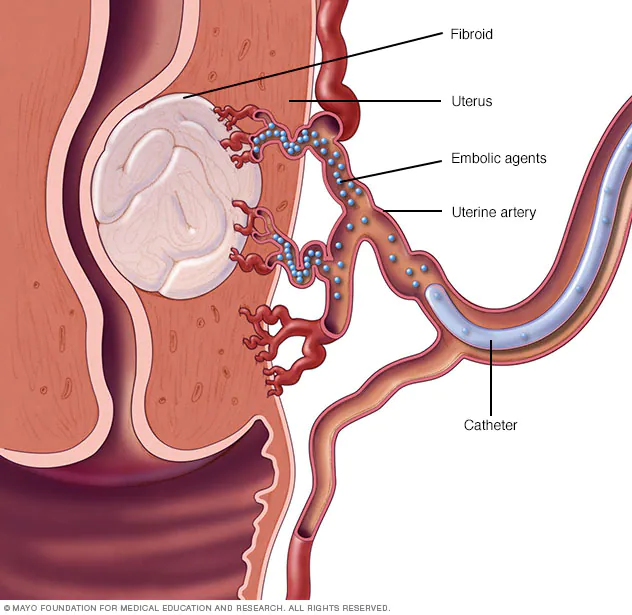Uterine Fibroid Embolisation
Uterine fibroid embolisation (UFE) is a minimally-invasive, image-guided alternative to the invasive surgical procedures used to remove uterine fibroids.

What is UFE?
UFE has been used to treat uterine fibroids for over 20 years and has an established role in the management of symptomatic fibroids. It has been shown to reduce symptoms and provide lasting results in up to 95% of cases and is approved by Medicare.
This is a complex procedure that can only be performed by a specialist interventional radiologist with expertise in the area.
How is UFE Performed?
Uterine fibroid embolisation is generally done under sedation and a local anaesthetic. This may make UFE a viable option for women who can’t have the general anaesthetic used for more invasive treatments.
Following sedation, an interventional radiologist will insert a tiny catheter through the wrist or groin and manoeuvre it into the uterine artery under X-ray guidance. Tiny particles are then injected into the arteries supplying the fibroids, reducing their blood flow and causing them to shrink and die over time. The whole procedure takes about 90 minutes. No abdominal incisions or scars are made, and no stitches are needed.
After the procedure, you will need to remain in the hospital overnight. If you can eat and drink normally in the morning and your pain is controlled, you can go home.
Here is a video further explaining the process, courtesy of Fairfax Radiology:
What are the Benefits of UFE?
Although UFE is not suitable for anyone, it has some benefits over traditional surgical management of fibroids (myomectomy) and management through medication.
- It’s safer than other alternatives – Current evidence and clinical study show that the risk of major complications is lower for UFE than other surgical fibroid treatment options.
- It’s effective – clinical studies have shown that UFE provides lasting relief from fibroid symptoms in 90-95% of women.
- It doesn’t preclude other treatments (if required) – For those who remain symptomatic, surgical options remain possible after UFE.
- Its recovery period is shorter – since surgical incisions aren’t used and damage to the body’s tissues is minimised, recovery is usually much quicker compared to invasive surgery methods.
UFE is also supported by the UK’s National Institute for Health and Care Excellence (NICE), the UK and US Colleges of Obstetricians and Gynaecologists, and the Cochrane Review, the international body that publishes guidance for physicians based on all available evidence. It is also endorsed by Australian RANZCOG, who state that the UFE is an effective, less invasive alternative to traditional methods, with fewer complications and quicker recovery than alternative methods.
What are the Risks of UFE?
UFE is generally considered to be a very safe procedure, but like all surgical procedures it carries a small risk of complications.
- Haematoma – a small bruise may form at the needle’s insertion site. This is quite normal and nothing to be concerned about. If it develops into a large bruise, it may need to be treated with antibiotics.
- Fibroid detachment – 2-3% of women will pass small pieces of fibroid a few months after the procedure. This happens when the fibroid dies and detaches from the uterine wall, and is not usually dangerous.
- Pelvic pain – Many patients experience some mild pain in the days following the procedure. This may feel similar to period pains, and can usually be managed with over-the-counter painkillers and anti-inflammatory medication.
- Infection – the uterus and needle insertion site may become infected if they are not adequately cared for in the following days.
- Hysterectomy – in very rare cases, UFE can lead to complications and infections which result in the uterus needing removal. This eliminates your ability to have children later on, but is very uncommon.
What is Recovery Like?
Following your UFE, you will be given a prescription for antibiotics and advised to take painkillers and anti-inflammatory medication. Exercise, heavy lifting, bathing, intercourse, and using tampons should be avoided for the first week post-procedure to reduce the risk of infection and complications.
During the recovery period, it’s common to feel tired, have a low-grade fever, and experience some mild abdominal cramping. These symptoms usually settle in about a week.

Who Can Undergo UFE?
UFE is not suitable for all people. However, it is a viable fibroid solution for:
- Women who want to have children in the future, as unlike some other surgical treatment methods, UFE preserves the uterus and does not negatively impact your ability to have children later on.
- Women whose fibroid symptoms are poorly controlled on medication, as UFE addresses the root source of the symptoms.
- Women who can’t have/don’t want surgery, as the risk of complications is lower and the procedure can be performed under sedation (rather than a general anaesthetic).
- Women who are conscious about their appearance, as UFE doesn’t cause the surgical scars that many other fibroid treatments do.
- Women who need to work, as the recovery period is much shorter than for other surgical treatments.
Who Can’t Have UFE?
Whether or not it’s right for you and your suitability for uterine artery embolisation will be determined through your MRI and other testing. You may not be suitable for UFE if:
- You have a single fibroid next to the lining of the womb – this is best removed surgically.
- Your fibroids don’t have a good supply – UFE works by blocking off blood supply to the fibroids, and will have decreased results if the blood supply is poor.
- If you don’t have symptoms form fibroids – if your fibroids aren’t causing pain or fertility trouble, they usually don’t need to be treated.
- You’re pregnant – it’s unsafe to perform a UFE if you’re pregnant, as it could cause unintended consequences.
How Long Does it Take for the Fibroids to Shrink?
Although they won’t go away completely, the fibroids will shrink to a smaller size after 2-3 months. They may continue to shrink for the next year. Some may eventually detach from the uterine wall all together and be passed out of the body similar to a period.
For some people, fibroids shrink fast after embolisation and you may find relief as soon as your next menstrual cycle. For others, it can take a bit longer, but for most people, fibroids will shrink within 6 months of UFE.

Safe, effective treatments with less pain and quicker recovery.
Ensure you know all your options prior to invasive surgical treatment, schedule a consult with Dr Shaun Quigley.



